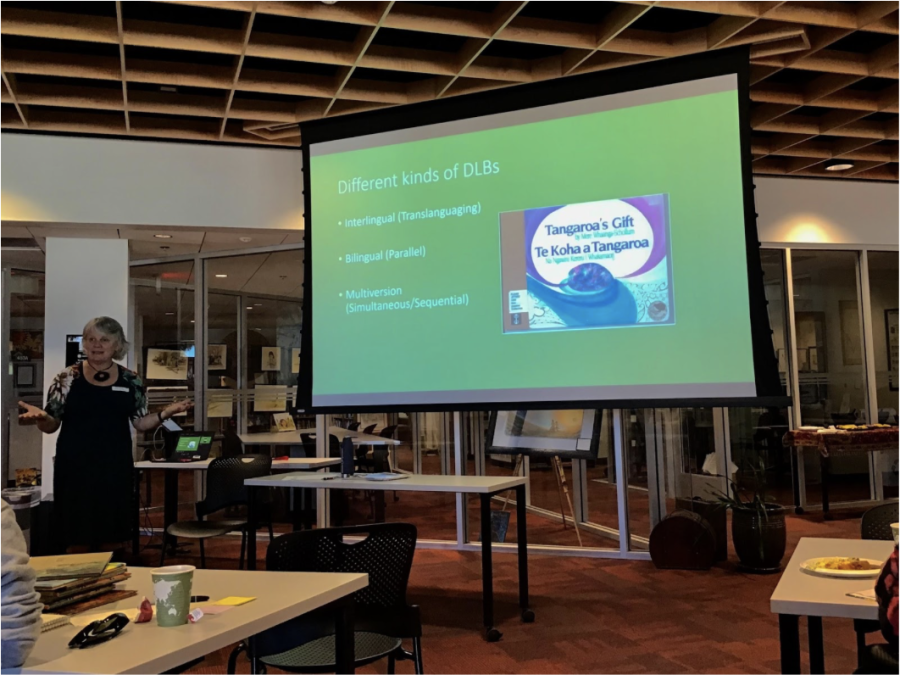In a city as diverse as Tucson, multilingual education is a necessity for perpetuating the preservation and mingling of cultures. New Zealand Fulbright scholar Nicola Daly recently led a workshop at the University of Arizona that proposed using dual-language picture books as a resource for early multilingual education.
On Saturday, February 15, the UA College of Education opened its doors for educators to explore the intricacies of dual-language picture books. Worlds of Words, a center of global literacies and literature, presented “Dual-Languages Picture Books in Multilingual Classrooms,” a workshop led by Daly.
According to Daly, dual-language books are books written in two languages. There are three categories of dual-language books: interlingual, bilingual and multi-version. Interlingual books have “translanguaging,” a process of integrating languages with each other — an interlingual book is written in one language, but has some words in another language. Bilingual books are written in two languages separately but within the same volume. Multi-version books are books that have versions published in multiple languages, either at the same time (simultaneous) or one after the other (sequential).
“Dual-language picture books are powerful resources, they can support linguistic diversity,” Daly said. “They recognize linguistic diversity.”
During the workshop, Daly spoke of the “linguistic landscape” of books, which authors can utilize to highlight dominant languages in books by changing the order of the included languages and the size and characteristic of the font. In an article Daly published in the Journal of Multilingual and Multicultural Development, she described the linguistic landscape as the language people see in public spaces, like commercial shops signs, road signs or public signs on government buildings.
“We sometimes just read the books and we don’t really point out the features of how a book is laid out,” said Kelly Strachan, a graduate student in teaching, learning and social-cultural studies.
Kathy Short, director of WOW, stated that WOW is a resource for the UA and Tucson community that provide workshops as a way to bring together educators in which they can think of how global literature might be used to create intercultural understanding.
RELATED: Local business owner accentuates southwestern culture in gift shop
“We want [students and educators] to value every culture in terms of the common humanity we all share, but also what makes each culture unique and distinct and to value both at the same time,” Short said.
WOW is promoting multilingualism to bring more positive awareness and attitudes towards other cultures and languages. According to Short, in the U.S. there is a lack of education about different cultures and a lack of necessity to learn other languages.
WOW aims to challenge the notion that American culture is the standard. Short explained that many local children face problems in schools because teachers don’t have the knowledge or tools necessary to teach multilingual children. Due to Tucson’s close proximity to the U.S.-Mexico border, the city has many multilingual children.
Daly believes that dual-language picture books should be used as resources in classrooms for children to teach awareness about languages other than English.
Short believes that in multicultural classrooms, where there are children whose family backgrounds vary, teachers should be conscious that those children’s background are valuable and beneficial for the whole class. Therefore, teachers should know how to teach those children so they can speak English without losing their cultural and language identities.
“[Dual-language picture books] are trying to pull on multiple languages as a resource — a positive resource,” Short said.
Daly stated that in diverse places like universities, it is important to have linguistics awareness because universities often teach and welcome international people who come to both learn from the locals and offer their own knowledge and cultural background to willing Americans.
Xiao Yin, a teaching, learning and socio-cultural doctoral student from China said that she learned English in China. When she came to the U.S., she realized that although it is an English-speaking country, Spanish has greatly influenced the language.
“English and Spanish are not necessarily two separate languages,” Yin said.
Yin added that in China, she used to teach English and Chinese in a school where she became aware that languages should not be taught separately.
“If we bring this kind of bilingual or interlingual books into a classroom then children get to know … all the languages can be used as a kind of resource,” Yin said.
The point of the workshop, according to Daly, was to educate and show that dual-language picture books enable people to remember that the world is bigger than they thought.
Follow Diana Ramos on Twitter















